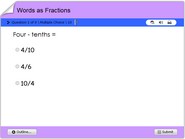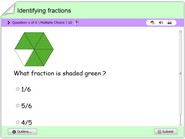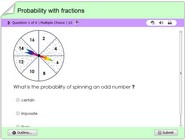Fractions vocabulary and expressions quiz
Practice and test your skills through Fractions vocabulary and expressions quiz
Math quiz to teach children vocabulary related to fractions
Math quiz to teach children vocabulary related to fractions. It is important for children to understand how to express fractions in words and vice-versa. Children should also understand concepts like denominator and numerator, multiples and factors. All these notions are essential for teaching topics related to fractions. It is therefore important to build a base for children in 1st, 2nd and 3rd grades to build on. This is an interactive multiple choice questions quiz.
Fractions are a way to represent a part of a whole or a part of a group. They are usually written as a number or letter over another number or letter, with a line separating the two. For example, “1/2” is read as “one-half,” “2/3” is read as “two-thirds,” and “3/4” is read as “three-fourths.”
There are several basic vocabulary words and expressions that are commonly used when talking about fractions:
- Numerator: The top number or letter in a fraction. For example, in the fraction “1/2,” the numerator is “1.”
- Denominator: The bottom number or letter in a fraction. For example, in the fraction “1/2,” the denominator is “2.”
- Fraction bar: The line separating the numerator and denominator in a fraction.
- Simplify: To rewrite a fraction in its simplest form. For example, “6/8” can be simplified to “3/4.”
- Equivalent fractions: Fractions that represent the same value, even though they may look different. For example, “1/2” and “2/4” are equivalent fractions because they both represent the same value (half).
- Mixed number: A number that is made up of a whole number and a fraction. For example, “2 1/2” is a mixed number.
- Improper fraction: A fraction where the numerator is larger than the denominator. For example, “7/4” is an improper fraction.
- Proper fraction: A fraction where the numerator is smaller than the denominator. For example, “1/2” is a proper fraction.
- Unit fraction: A fraction where the numerator is 1 and the denominator is a positive integer. For example, “1/2” is a unit fraction.
Now, let’s take a look at some common fractions and their corresponding vocabulary words and expressions:
- Half: “1/2” is called “half.”
- Third: “1/3” is called “one-third” or simply “a third.”
- Quarter: “1/4” is called “one-quarter” or simply “a quarter.”
- Fifth: “1/5” is called “one-fifth” or simply “a fifth.”
- Sixth: “1/6” is called “one-sixth” or simply “a sixth.”
- Seventh: “1/7” is called “one-seventh” or simply “a seventh.”
- Eighth: “1/8” is called “one-eighth” or simply “an eighth.”
- Ninth: “1/9” is called “one-ninth” or simply “a ninth.”
- Tenth: “1/10” is called “one-tenth” or simply “a tenth.”
Here are some examples of how these fractions and expressions can be used in sentences:
- “I need half a cup of sugar for this recipe.”
- “There are two thirds of a mile left until we reach our destination.”
- “I’m going to cut this pizza into quarters so that we can share it.”
- “There are five fifths in a whole.”
- “I’m going to divide this pie into sixths and save some for later.”
- “There are seven sevenths in a week.”
- “I’m going to pay you an eighth of the total cost.”



